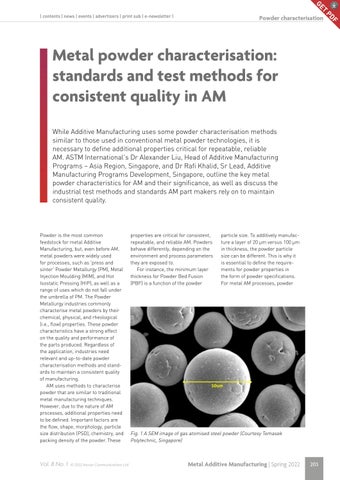T GE Powder characterisation
Metal powder characterisation: standards and test methods for consistent quality in AM While Additive Manufacturing uses some powder characterisation methods similar to those used in conventional metal powder technologies, it is necessary to define additional properties critical for repeatable, reliable AM. ASTM International's Dr Alexander Liu, Head of Additive Manufacturing Programs – Asia Region, Singapore, and Dr Rafi Khalid, Sr Lead, Additive Manufacturing Programs Development, Singapore, outline the key metal powder characteristics for AM and their significance, as well as discuss the industrial test methods and standards AM part makers rely on to maintain consistent quality.
Powder is the most common feedstock for metal Additive Manufacturing, but, even before AM, metal powders were widely used for processes, such as 'press and sinter' Powder Metallurgy (PM), Metal Injection Moulding (MIM), and Hot Isostatic Pressing (HIP), as well as a range of uses which do not fall under the umbrella of PM. The Powder Metallurgy industries commonly characterise metal powders by their chemical, physical, and rheological (i.e., flow) properties. These powder characteristics have a strong effect on the quality and performance of the parts produced. Regardless of the application, industries need relevant and up-to-date powder characterisation methods and standards to maintain a consistent quality of manufacturing. AM uses methods to characterise powder that are similar to traditional metal manufacturing techniques. However, due to the nature of AM processes, additional properties need to be defined. Important factors are the flow, shape, morphology, particle size distribution (PSD), chemistry, and packing density of the powder. These
Vol. 8 No. 1 © 2022 Inovar Communications Ltd
properties are critical for consistent, repeatable, and reliable AM. Powders behave differently, depending on the environment and process parameters they are exposed to. For instance, the minimum layer thickness for Powder Bed Fusion (PBF) is a function of the powder
particle size. To additively manufacture a layer of 20 µm versus 100 µm in thickness, the powder particle size can be different. This is why it is essential to define the requirements for powder properties in the form of powder specifications. For metal AM processes, powder
Fig. 1 A SEM image of gas atomised steel powder (Courtesy Temasek Polytechnic, Singapore)
Metal Additive Manufacturing | Spring 2022
203
F PD
| contents | news | events | advertisers | print sub | e-newsletter |
